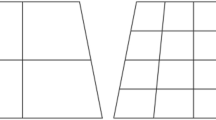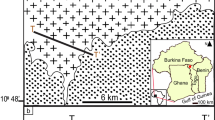Abstract
Three-dimensional distribution of karstic zones and estimated porosity were obtained in fractured carbonate units of the Salitre Formation (Brazil) from GPR data. Low-amplitude (shadow) GPR zones could be associated with mineral dissolution halos that developed around fractures and bedding planes. GPR volumes show a 3D mazelike geometry of the vertical karstified carbonate zones, similar to the set of passages controlled by ~ N–S and E–W oriented fracture systems, observed on the surface in unmanned aerial vehicle images. Measurements in plug samples indicate that the mineral dissolution caused bulk density and dielectric permittivity decline and incipient increase in porosity from 0.95 to 1.01%. These changes in the rock properties affect the EM impedance contrasts between carbonate bedding, causing loss of the reflected GPR signal. The correlation between dielectric permittivity and porosity could be analyzed using the complex refractive index model (CRIM), which is used to convert the relative dielectric permittivity into porosity. The CRIM porosities are somewhat lower than plug sample porosities due to different estimation methodologies and measurement scales. However, the fact that porosity is slightly higher in the dissolved carbonates was maintained. In addition, GPR amplitude and frequency instantaneous attributes were used to estimate spatial variability in porosity throughout the whole GPR data volume. The crossplot of these two GPR attributes show that altered zones generally cluster in narrow ranges of instantaneous GPR amplitude and in broad range of instantaneous GPR frequency. Assuming empirical correlation between physical properties and GPR attributes two predicted porosity volumes were established for the karstified carbonates in the studied area.












Similar content being viewed by others
References
Agosta, F., Alessandroni, M., Antonellini, M., Tondi, E., & Giorgioni, M. (2010). From fractures to flow: A field-based quantitative analysis of an outcropping carbonate reservoir. Tectonophysics, 490, 197–213.
Almeida, F. F. M., Brito Neves, B. B., & Carneiro, C. D. R. (2000). The origin and evolution of the South American Platform. Earth-Science Reviews, 50, 77–111.
Amthor, J., & Friedman, G. (1991). Dolomite-rock textures and secondary porosity development in Ellenburger Group carbonates (Lower Ordovician), west Texas and southeastern New Mexico. Sedimentology, 38, 343–362.
Auler, A. S., Klimchouk, A., Bezerra, F. H. R., Cazarin, C. L., Ennes-Silva, R., & Balsamo, F. (2017). Origin and evolution of Toca da Boa Vista and Toca Da Barriguda cave system in north-eastern Brazil. In A. Klimchouk, A. Palmer, J. Waele, A. S. Auler, & P. Audra (Eds.), Cave and Karst Systems of the World (1st ed., pp. 827–840). Berlim: Springer International Publishing.
Auler, A. S., & Smart, P. L. (2003). The influence of bedrock-derived acidity in the development of surface and underground karst: evidence from the Precambrian carbonates of semi-arid Northeastern Brazil. Earth Surface Processes and Landforms, 28, 157–168.
Billi, A. (2005). Grain size distribution and thickness of breccia and gouge zones from thin (< 1 m) strike-slip fault cores in limestone. Journal of Structural Geology, 27, 1823–1837.
Birchak, J. R., Gardner, C. G., Hipp, J. E., & Victor, J. M. (1974). High dielectric constant microwave probes for sensing soil moisture. roceedings of the Institute of Electrical and Electronics Engineers, 62(1), 93–98.
Brito Neves, B. B., & Cordani, U. G. (1991). Tectonic evolution of South America during the Late Proterozoic. Precambrian Research, 53, 23–40.
Cassidy, N. J. (2007). Evaluating LNAPL contamination using GPR and dielectric analysis: Practical implications for signal attenuation and attribute analysis studies. Journal of Contaminant Hydrology, 94(1–2), 49–75.
Cassidy, N. J. (2009). Ground penetrating radar data processing, modelling and analysis (chapter 5). In H. M. Jol (Ed.), Ground penetrating radar theory and applications (p. 524). Amsterdam: Elsevier Science.
Corbeanu, R., McMechan, G. A., Szerbiak, R., & Soegaard, K. (2002). Prediction of 3D fluid permeability and mudstone distributions from ground-penetrating radar (GPR) attributes: Example from the Cretaceous Ferron Sandstone Member, east-central Utah. Geophysics, 67, 1495–1504.
Daniels, D. J. (1996). Surface penetrating radar, radar, sonar, navigation and avionics series 6. London: The Institute of Electrical Engineers.
Endres, A., & Knight, R. (1992). A theoretical treatment of the of microscopic fluid distribution on the dielectric properties of partially saturated rocks. Geophysical Prospecting, 37, 531–551.
Ennes-Silva, R. A., Bezerra, F. H. R., Nogueira, F. C. C., Balsamo, F., Klimchouk, A., Cazarin, C. L., et al. (2016). Superposed folding and associated fracturing influence hypogene karst development in Neoproterozoic carbonates, São Francisco Craton, Brazil. Tectonophysics, 666, 244–259.
Fernandes, A. L., Jr., Medeiros, W. E., Bezerra, F. H. R., Oliveira, J. G., & Cazarin, C. L. (2015). GPR investigation of karst guided by comparison with outcrop and unmanned aerial vehicle imagery. Journal of Applied Geophysics, 112, 268–278.
Forster, C. B., H. Snelgrove, S. J. Lim, R. M. Corbeanu, G. A. McMechan, K. Soegaad, R. B. Szerbiak, L. Crossey, & K. Roche, (2004). 3D fluid flow simulation in a clastic reservoir analogue, based in integration 3D GPR and outcrop data from the Ferron Sandstone at Coyote Basin, Utah. In T. C. Chidsey, R. D. Adams, & T. H. Morris (Eds.), Regional to wellbore analog for fluvial-deltaic reservoir modeling: The Ferron Sandstone of Utah, AAPG in Geology (vol. 50, pp. 405–425).
Gale, J., & Gomez, L. (2007). Late opening-mode fractures in karst brecciated dolostones of the Lower Ordovician Ellenburger Group, west Texas: recognition, characterization, and implications for fluid flow. AAPG Bulletin, 91, 1005–1023.
Gawthorpe, R.L., Collier, R.E.L., Alexander, J., Bridge, J.S., Leeder, M.R. (1993). Ground-penetrating radar: application to sandbody geometry and heterogeneity studies. In North, C.P., Prosser, D.J. (Eds.), Characterization of fluvial and aeolian reservoirs (pp. 421–432). The Geological Society, Special Publication No. 73.
Harbi, H., & McMechan, G. A. (2011). Modeling 3D porosity and permeability from GPR data in the Ellenburger Dolomite, central Texas. Geophysics, 76(6), J35–J46.
Klimchouk, A., Auler, A. S., Bezerra, F. H. R., Cazarin, C. L., Balsamo, F., & Dublyansky, Y. (2016). Hypogenic origin, geologic controls and functional organization of a giant cave system in Precambrian carbonates, Brazil. Geomorphology, 253, 385–405.
Lonergan, L., Jolly, R.H.J., Rawnsley, K., Sanderson, D.J. (2007). Fractured reservoirs. Geological Society of London, Special Publication, No. 270.
Loucks, R. G., Mescher, P., & McMechan, G. A. (2004). Three-dimensional architecture of a coalesced, collapsed-paleocave system in the Lower Ordovician Ellenburger Group, Central Texas. American Association of Petroleum Geologists Bulletin, 88, 545–564.
Lucia, F. J. (2007). Carbonate reservoir characterization electronic resource: An integrated approach (p. 226). Berlin: Springer-Verlag.
Misi, A., & Kyle, J. R. (1994). Upper Proterozoic carbonate stratigraphy, diagenesis, and stromatolitic phosphorite formation, Ireĉe Basin, Bahia. Brazil. Journal of Sedimentary Research, A64, 299–310.
Mount, G. J., Comas, X., & Cunningham, K. J. (2014). Characterization of the porosity distribution in the upper part of the karst Biscayne aquifer using common offset ground penetrating radar, Everglades National Park, Florida. Journal of Hydrology, 515, 223–236.
Questiaux, J. M., Couples, G. D., & Ruby, N. (2010). Fractured reservoirs with fracture corridors. Geophysical Prospecting, 58, 279–295.
Reis, J. A., Jr., de Castro, D. L., Jesus, T. E. S., & Lima Filho, F. P. (2014). Characterization of collapsed paleocave systems using GPR attributes. Journal of Applied Geophysics, 103, 43–53.
Robertson, J. D., & Nogami, H. H. (1984). Complex seismic trace analysis of thin beds. Geophysics, 49, 344–352.
Taner, M. T., Koehler, F., & Sheriff, R. E. (1979). Complex trace analysis. Geophysics, 44, 1041–1063.
Trice, R. (2014). Basement exploration, West of Shetlands: progress in opening a new play on the UKCS. In S. J. C. Cannon, & D. Ellis (Eds.), Hydrocarbon exploration to exploitation west of Shetlands (pp. 81–105). Geological Society, London, Special Publications, No. 397(1).
Tronicke, J., & Paasche, H. (2017). Integrated interpretation of 2D ground-penetrating radar, P-, and S-wave velocity models in terms of petrophysical properties: assessing uncertainties related to data inversion and petrophysical relations. Interpretation, 5(1), T121–T130.
Acknowledgements
This research was supported by Petrobras and Universidade Federal do Rio Grande do Norte (UFRN), Advanced Project of acquisition and interpretation of parameters for characterization and modeling of carbonate reservoirs—Procarste Project—Grant No. 2015/00369-0. The authors are grateful to the Laboratório de Análises Estratigráficas (LAE—UFRN), coordinated by Francisco P. Lima Filho, the CNPq Project INCT-ET, coordinated by Reinhardt A. Fuck (Universidade de Brasília), who supported the GPR surveys with equipment and vehicle, and the Brazilian Oil Agency (Agência Nacional do Petróleo, Gás e Biocombustíveis, ANP). We also thank Narendra K. Srivastava for his help with petrographic analysis and dissolution processes. IMMC thanks Petrobras for her MSc scholarship and DLC and FHRB thank the Brazilian Scientific Council (Conselho Nacional de Desenvolvimento Científico e Tecnológico, CNPq) for their research grants. We are grateful to the associate editor P. Keating, A. Casas and another anonymous reviewer for valuable comments that helped to improve this manuscript.
Author information
Authors and Affiliations
Corresponding author
Rights and permissions
About this article
Cite this article
Conti, I.M.M., de Castro, D.L., Bezerra, F.H.R. et al. Porosity Estimation and Geometric Characterization of Fractured and Karstified Carbonate Rocks Using GPR Data in the Salitre Formation, Brazil. Pure Appl. Geophys. 176, 1673–1689 (2019). https://doi.org/10.1007/s00024-018-2032-5
Received:
Revised:
Accepted:
Published:
Issue Date:
DOI: https://doi.org/10.1007/s00024-018-2032-5




